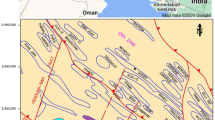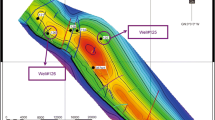Abstract
The natural fractures are dominated factors for the gas yield in deeply buried tight sandstones of Lower Cretaceous Bashijiqike Formation of KS5 well area, Kuqa Depression. For the high temperature and pressure environment, boreholes were drilled in oil-based mud. To characterize fractures in ultra-deep formation, electrical imagers (High-definition Formation MicroImager (FMI-HD), Earth Imager (EI), and Oil Base MicroImager (OBMI)) and acoustic imagers (Circumferential Borehole Imaging Log (CBIL) and Ultrasonic Borehole Imager (UBI)) were run in five oil-based mud openholes in KS5 well area. In this paper, fractures in different classifications were interpreted and compared in various borehole images. Opened and partially opened fractures were, respectively, continuous and discontinuous bright sinusoidal traces in electrical images. Closed fractures should be recognized by electrical and acoustic images cooperatively. In Bashijiqike Formation, opened and partially opened medium-angle, high-angle, and network fractures were well developed, while low-angle fractures were infrequent. Bashijiqike Formation might be divided into fractures well-developed, no-developed, and less-developed intervals upwards vertically. The strikes of fractures concentrated in nearly NWW-SEE, paralleled the strikes of major faults. This paper might help in understanding the complete vertical distributional characteristics of fractures in tight sandstones of Lower Cretaceous Bashijiqike Formation of KS5 well area and in turn on the exploration potential of petroleum systems.
















Similar content being viewed by others
References
Abdideh M, Amanipoor H (2012) Fractures and borehole breakouts analysis of a reservoir using an image log (Case study: SW Iran). Pet Sci Technol 30:2360–2372. https://doi.org/10.1080/10916466.2010.512895
Aghli G, Soleimani B, Moussavi-Harami R, Mohammadian R (2016) Fractured zones detection using conventional petrophysical logs by differentiation method and its correlation with image logs. J Pet Sci Eng 142:152–162. https://doi.org/10.1016/j.petrol.2016.02.002
Ameen MS, Buhidma IM, Rahim Z (2010) The function of fractures and in-situ stresses in the Khuff reservoir performance, onshore fields, Saudi Arabia. AAPG Bull 94(1):27–60. https://doi.org/10.1306/06160909012
Ameen MS, MacPherson K, Al-Marhoon MI, Rahim Z (2012) Diverse fracture properties and their impact on performance in conventional and tight-gas reservoirs, Saudi Arabia: the Unayzah, South Haradh case study. AAPG Bull 96(3):459–492. https://doi.org/10.1306/06011110148
Canady W, Market J (2008) Fracture characterizations by borehole logging methods. SPWLA 49th Annual Logging Symposium, AAA
Cheung PS-Y, Heliot D (1990) Workstation-based fracture evaluation using borehole images and wireline logs. 65th Annual Technical Conference and Exhibition of the SPE, New Orleans, LA, SPE 20573. https://doi.org/10.2118/20573-MS
Evans DJ, Kingdon A, Hough E, Reynolds W, Heitmann N (2012) First account of resistivity borehole micro-imaging (FMI) to assess the sedimentology and structure of the Preesall Halite, NW England: implications for gas storage and wider applications in CCS caprock assessment. J Geol Soc Lond 169:587–592. https://doi.org/10.1144/0016-76492011-143
Gaillot P, Brewer T, Pezard P, Yeh E-C (2007) Borehole imaging tools-principles and applications. Scient Dril 5:1–4. https://doi.org/10.2204/iodp.sd.5.07S1.2007
Gozalpour F, Danesh A, Todd AC, Tohidi B (2007) Application of tracers in oil-based mud for obtaining high-quality fluid composition in lean gas/condensate reservoirs. SPE Reserv Eval Eng 10(1):5–11. https://doi.org/10.2118/94067-PA
Hou GT, Sun S, Zheng CF, Tang YG, Zhou L, Mo T (2019) Subsalt structural styles of Keshen Section in Kelasu Tectonic Belt. Mar Xinjiang Petrol Geol 40(1):21–26. https://doi.org/10.7657/XJPG20190103
Khoshbakht F, Memarian H, Mohammadnia M (2009) Comparison of Asmari, Pabdeh and Gurpi formation's fractures, derived from image log. J Pet Sci Eng 67:65–74. https://doi.org/10.1016/j.petrol.2009.02.011
Kumano Y, Tamagawa T, Tezuka K (2011) Characterization of productive fractures based on borehole resistivity imaging and geomechanical analysis at Yufutsu fractured reservoir. SPWLA 52nd Annual Logging Symposium
Lai J, Wang GW, Fan ZY, Wang ZY, Chen J, Zhou ZL, Wang SC, Xiao CW (2017) Fracture detection in oil-based drilling mud using a combination of borehole image and sonic logs. Mar Pet Geol 84:195–214. https://doi.org/10.1016/j.marpetgeo.2017.03.035
Lai J, Wang GW, Wang S, Cao JT, Li M, Pang XJ, Han C, Fan XQ, Yang L, He ZB, Qin ZQ (2018a) A review on the applications of image logs in structural analysis and sedimentary characterization. Mar Pet Geol 95:139–166. https://doi.org/10.1016/j.marpetgeo.2018.04.020
Lai J, Wang GW, Cao JT, Xiao CW, Wang S, Pang XJ, Dai QQ, He ZB, Fan XQ, Yang L, Qin ZQ (2018b) Investigation of pore structure and petrophysical property in tight sandstones. Mar Pet Geol 91:179–189. https://doi.org/10.1016/j.marpetgeo.2017.12.024
Lambertini R (1992) Fracture identification and quantification using borehole images: Maracaibo Basin, Venezuela. 2nd Latin American Petroleum Engineering Conference of the SPE Caracas, Venezuela, SPE 23637. https://doi.org/10.2523/23637-MS
Li Y, Guo S, Wang X, Hou YF, Neng Y, Wang ZX, Zhou L, Yang WJ, Tan C (2017) Stratification model of an ultra-deep tight sandstone fracture reservoir under tectonic stress: A case study of a Cretaceous reservoir in the Kuqa foreland thrust belt of the Tarim Basin. J Nat Gas Sci Eng 45:53–64. https://doi.org/10.1016/j.jngse.2017.05.010
Li Y, Hou GT, Hari KR, Neng Y, Lei GL, Tang YG, Zhou L, Sun S, Zheng CF (2018) The model of fracture development in the faulted folds: The role of folding and faulting. Mar Pet Geol 89:243–251. https://doi.org/10.1016/j.marpetgeo.2017.05.025
Liu C, Zhang RH, Zhang HL, Wang B, Huang W (2017a) Fracture development of different structural styles in Kuqa foreland thrust belt: From outcrop observation of structural fracture. Nat Gas Geosci 28(1):52–61. https://doi.org/10.11764/j.issn.1672-1926.2016.11.020
Liu C, Zhang RH, Zhang HL, Wang JP, Mo T, Wang K, Zhou L (2017b) Genesis and reservoir significance of multi-scale natural fractures in Kuqa foreland thrust belt, Tarim Basin, NW China. Pet Explor Dev 44(3):463–472. https://doi.org/10.11698/PED.2017.03.17
Movahed Z, Juninb R, Safarkhanlou Z, Akbar M (2014) Formation evaluation in Dezful Embayment of Iran using oil-based-mud imaging techniques. J Pet Sci Eng 121:23–37. https://doi.org/10.1016/j.petrol.2014.05.019
Nian T, Wang GW, Tan CQ, Fei LY, Wang S (2021) Hydraulic apertures of barren fractures in tight-gas sandstones at depth: Image-core calibration in the lower cretaceous Bashijiqike Formation, Tarim Basin. J Pet Sci Eng 196:108016. https://doi.org/10.1016/J.PETROL.2020.108016
Prioul R, Jocker J (2009) Fracture characterization at multiple scales using borehole images, sonic logs, and walkaround vertical seismic profile. AAPG Bull 93(11):1503–1516. https://doi.org/10.1306/08250909019
Qu HZ, Zhang FX, Wang ZY, Yang XT, Liu HT, Ba D, Wang X (2016) Quantitative fracture evaluation method based on core-image logging: A case study of Cretaceous Bashijiqike Formation in ks2 well area, Kuqa Depression, Tarim Basin, NW China. Pet Explor Dev 34(3):425–452. https://doi.org/10.11698/PED.2016.03.13
Rogers SF, Bailey DE, Kingdon A (2000) Orientation of drill core by use of borehole geophysical imaging. Appl Earth Sci 109(3):184–190. https://doi.org/10.1179/aes.2000.109.3.184
Schlumberger (2002) UBI: Ultrasonic borehole imager. Schlumberger brochure, https://www.slb.com/~/media/Files/evaluation/brochures/wireline_open_hole/geology/ubi_br.pdf, accessed 7 Nov 2020
Schlumberger (2006) OBMI: Oil-base microimager. Schlumberger brochure, https://www.slb.com/~/media/Files/evaluation/brochures/wireline_open_hole/geology/obmi_br.pdf, accessed 7 Nov 2020
Schlumberger (2013) FMI-HD: High-definition formation microimager. Schlumberger brochure, https://www.slb.com/~/media/Files/evaluation/brochures/wireline_open_hole/geology/fmi-hd_br.pdf, accessed 7 Nov 2020
Shi CQ, Wang ZT, Zhu WH, Jiang J, Zhang HF, Zhou SY, Lou H, Zuo XJ, Li G, Wang ZH (2020) Fracture characteristic and its impact on reservoir quality of ultra-deep reservoirin Dabei region, Kelasu tectonic belt, Kuqa Depression, Tarim Basin. Nat Gas Geosci 31(12):1687–1699. https://doi.org/10.11764/j.issn.1672-1926.2020.02.001
Stephen P (2012) Recent developments in well logging and formation evaluation. World Oil 233(6):25–25
Sun S, Hou GT, Zheng CF (2017) Fracture zones constrained by neutral surfaces in a fault-related fold: Insights from the Kelasu tectonic zone, Kuqa Depression. J Struct Geol 104:112–124. https://doi.org/10.1016/j.jsg.2017.10.005
Thompson L (2009) Atlas of borehole imagery, 2nd edition. AAPG Discovery Series 13
Wang K, Wang GW, Xu B, Wang D, Ran Y (2015) Fracture classification and tectonic fractures in Keshen 2 well area. Prog Geophys 30(3):1251–1256. https://doi.org/10.6038/pg20150334
Wei GQ, Wang JP, Zeng LB, Tang YL, Wang K, Liu TT, Yang Y (2020) Structural reworking effects and new exploration discoveries of subsalt ultra-deep reservoirs in the Kelasu tectonic zone. Nat Gas Ind 40(1):20–30. https://doi.org/10.3787/j.issn.1000-0976.2020.01.003
Yuan R, Zhang CM, Tang Y, Qu JH, Guo XD, Sun YQ, Zhu R, Zhou YQ (2017) Utilizing borehole electrical images to interpret lithofacies of fan-delta: A case study of Lower Triassic Baikouquan Formation in Mahu Depression, Junggar Basin, China. Open Geosci 9(1):539–553. https://doi.org/10.1515/geo-2017-0041
Zazoun RS (2013) Fracture density estimation from core and conventional well logs data using artificial neural networks: The Cambro-Ordovician reservoir of Mesdar oil field, Algeria. J Afr Earth Sci 83:55–73. https://doi.org/10.1016/j.jafrearsci.2013.03.003
Zhang Y, Han DL, Yang CY, Yuan R, Wang CC, Zhang J (2020) Migration law of fracture filling fluid in ultra-deep clastic reservoirs: a case study of the Cretaceous Bashijiqike Formation in Keshen well block, Kuqa depression. Acta Petrol Sin 41(3):292–300. https://doi.org/10.7623/syxb202003004
Zhou P, Yin HW, Zhou L, Tang YG, Li CS, Zhu WH, Xie YN, Shang JW (2018) Reservoir controlling factor and forecast of tensional zone in geostrain neutral plane of faulted anticline: Example from Kelasu Fold-Thrust Belt. Geotecton Metallog 42(1):50–59. https://doi.org/10.16539/j.ddgzyckx.2018.01.004
Acknowledgments
The authors are thankful to the anonymous reviewers for their constructive reviews on the manuscript and the editors for carefully revising the manuscript.
Funding
This research was supported by National Science and Technology Major Project (No. 2017ZX05008003-050), Hubei Provincial Natural Science Foundation of China (No. 2019CFB343), and National Natural Science Foundation of China (No. 11871118). These supports are gratefully acknowledged.
Author information
Authors and Affiliations
Corresponding author
Ethics declarations
Conflict of interest
The authors declare that they have no competing interests.
Additional information
Responsible Editor: François Roure
Rights and permissions
About this article
Cite this article
Yuan, R., Han, D., Tang, Y. et al. Fracture characterization in oil-based mud boreholes using image logs: example form tight sandstones of Lower Cretaceous Bashijiqike Formation of KS5 well area, Kuqa Depression, Tarim Basin, China. Arab J Geosci 14, 435 (2021). https://doi.org/10.1007/s12517-021-06750-y
Received:
Accepted:
Published:
DOI: https://doi.org/10.1007/s12517-021-06750-y




